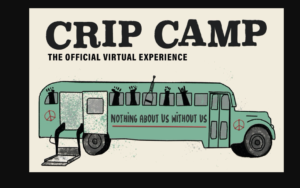Calling Up Justice uses the term “crip” as a reclaiming and liberating terminology. We also recognize the different feeling and relationships people have with this terminology. It is utilized in different ways depending on context and community. We created this resource for greater group understanding.
Disabled people have been reclaiming the word “crip” as a way of expressing pride in their identities, resilience in their struggles for rights and equity, and resistance against ableism and oppression. The term “crip” originated in the disability community in the 1980s as a way to unite people with different kinds of disabilities and avoid hierarchy among them. It was also a way to disempower the term’s historical pejorative usages and to identify other people who identify as “crips.”
The use of “crip” has also been incorporated into disability theory and studies, particularly in the development of crip theory. Crip theory is a way of exploring the experience of disability, acknowledging the history of exclusion of the disability community, and addressing social barriers related to disability. This theory has also intersected with gender and sexuality and is a part of critical disability studies.
However, the reclaiming of “crip” is not universally accepted by disabled people. There are critiques about the use of the term, particularly its potential associations with Crip gangs in the United States. Some disabled people argue that the use of “crip” can maintain harmful views of disabled people and perpetuate the marginalization and oppression of disabled people. They also argue that the term can be triggering to people impacted by racialized class violence, particularly the War on Drugs.
As a result, some disabled people prefer to use alternatives such as “dis” or “disability” “spoony”and use them interchangeably with “crip.” These alternatives can provide a more inclusive and less triggering language for the disability community.
Despite these controversies, the reclamation of the term “Crip” has played an important role in the disability rights movement, and has helped to challenge ableist attitudes and to create a more inclusive and equitable society for people with disabilities. As disability rights activist and scholar Rosemarie Garland-Thomson has argued, the term “Crip” is a powerful symbol of resistance and resilience, and a testament to the strength and resilience of the disability community.
CRIP used by Disabled Community
Coming to Claim Crip: Disidentification with/in Disability Studies Sami Schalk https://dsq-sds.org/article/view/3705
CripTime Defined: https://callingupjustice.com/day-19-crip-time-30-days-of-racial-and-disabled-justice/
CripCamp Documentary Film https://cripcamp.com/

